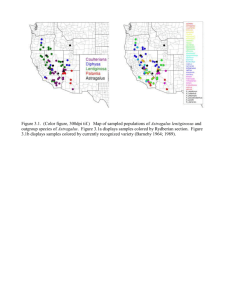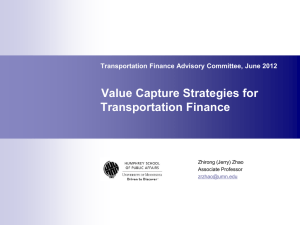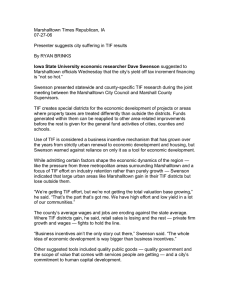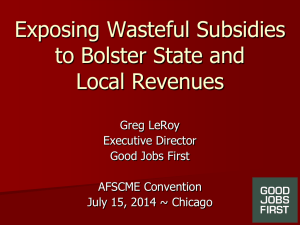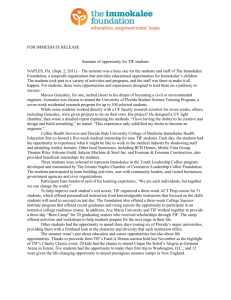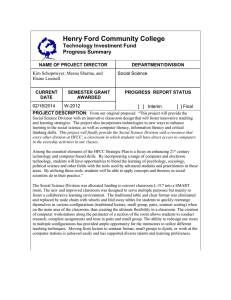Teacher Incentive Fund
advertisement
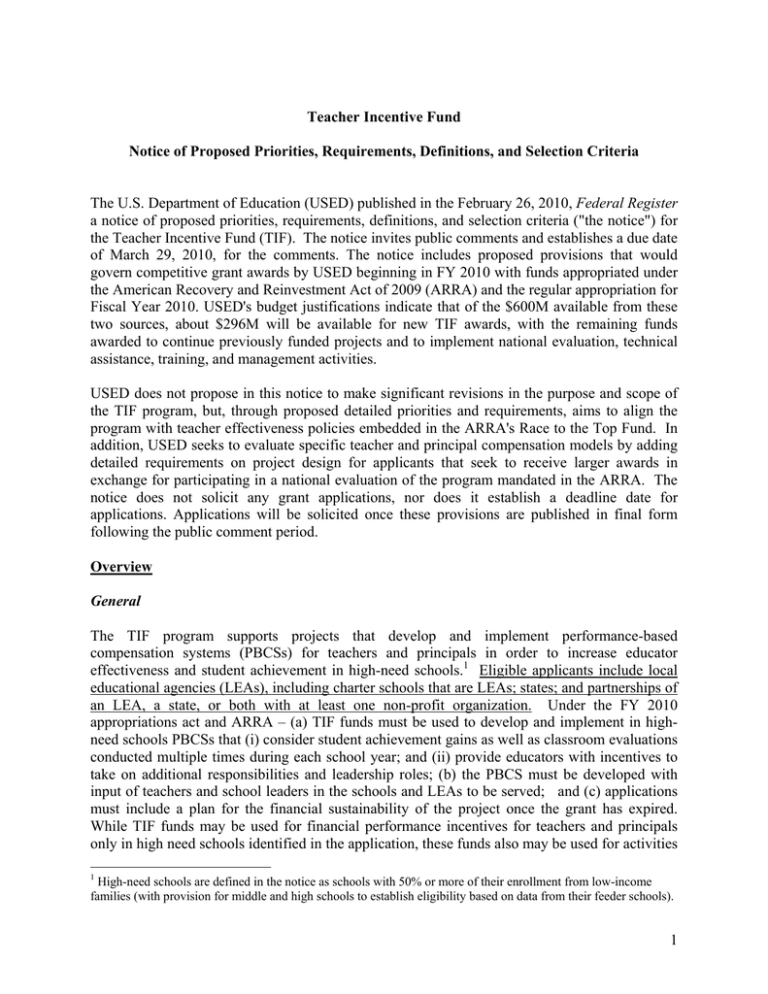
Teacher Incentive Fund Notice of Proposed Priorities, Requirements, Definitions, and Selection Criteria The U.S. Department of Education (USED) published in the February 26, 2010, Federal Register a notice of proposed priorities, requirements, definitions, and selection criteria ("the notice") for the Teacher Incentive Fund (TIF). The notice invites public comments and establishes a due date of March 29, 2010, for the comments. The notice includes proposed provisions that would govern competitive grant awards by USED beginning in FY 2010 with funds appropriated under the American Recovery and Reinvestment Act of 2009 (ARRA) and the regular appropriation for Fiscal Year 2010. USED's budget justifications indicate that of the $600M available from these two sources, about $296M will be available for new TIF awards, with the remaining funds awarded to continue previously funded projects and to implement national evaluation, technical assistance, training, and management activities. USED does not propose in this notice to make significant revisions in the purpose and scope of the TIF program, but, through proposed detailed priorities and requirements, aims to align the program with teacher effectiveness policies embedded in the ARRA's Race to the Top Fund. In addition, USED seeks to evaluate specific teacher and principal compensation models by adding detailed requirements on project design for applicants that seek to receive larger awards in exchange for participating in a national evaluation of the program mandated in the ARRA. The notice does not solicit any grant applications, nor does it establish a deadline date for applications. Applications will be solicited once these provisions are published in final form following the public comment period. Overview General The TIF program supports projects that develop and implement performance-based compensation systems (PBCSs) for teachers and principals in order to increase educator effectiveness and student achievement in high-need schools.1 Eligible applicants include local educational agencies (LEAs), including charter schools that are LEAs; states; and partnerships of an LEA, a state, or both with at least one non-profit organization. Under the FY 2010 appropriations act and ARRA – (a) TIF funds must be used to develop and implement in highneed schools PBCSs that (i) consider student achievement gains as well as classroom evaluations conducted multiple times during each school year; and (ii) provide educators with incentives to take on additional responsibilities and leadership roles; (b) the PBCS must be developed with input of teachers and school leaders in the schools and LEAs to be served; and (c) applications must include a plan for the financial sustainability of the project once the grant has expired. While TIF funds may be used for financial performance incentives for teachers and principals only in high need schools identified in the application, these funds also may be used for activities 1 High-need schools are defined in the notice as schools with 50% or more of their enrollment from low-income families (with provision for middle and high schools to establish eligibility based on data from their feeder schools). 1 for the entire LEA such as developing or improving systems and tools (e.g., teacher evaluations and tools to measure student achievement growth to enhance the quality of the PBCS); professional development; evaluation and research analysis; and data system enhancement or development. Under the notice, grants would be made for a five year period. Funds could not be used to support schools already served or to be served by current TIF grants, but a recipient of a current TIF project could apply for funds to implement a new TIF project in different schools. Two Competitions Consistent with provisions in the ARRA that require a national evaluation, the notice would provide for two separate competitions: the "Main TIF competition" to support implementation of PBCSs and the "TIF Evaluation competition," which will provide enhanced funding to support implementation of PBCSs in exchange for an agreement to participate in the national evaluation. Under the ARRA, the national evaluation – conducted by USED's Institute of Education Sciences (IES) in a select group of PBCSs in one or more LEAs – must use a randomized controlled methodology to the extent feasible, meaning that IES must ensure adequate participation of a "treatment group" of schools and a "control group" of schools in the evaluation. The notice does not indicate how many projects would likely be funded under each competition or how the funds would be divided between them. Applicants may apply for either the Main TIF competition or the TIF Evaluation competition. However, selections for TIF Evaluation grants will be made first, so those applications that are not selected as part of that competition will automatically be reviewed for funding as part of the Main TIF competition (without submitting a separate application). Subject to several additional requirements applicable to the TIF Evaluation competition, the priorities, requirements, definitions, and selection criteria are the same for both competitions. Priorities The notice proposes five priorities for both the Main TIF competition and the TIF Evaluation competition: o Priority 1: (An "Absolute priority," meaning the application must meet this priority to be funded): The project must provide differentiated levels of compensation for effective teachers and principals in high-need schools. In determining teacher effectiveness, the LEA must give significant weight to "student growth" (defined consistent with the Race to the Top definition) based on objective student performance data; must include observation-based assessments of teacher performance at multiple points in the year by evaluators trained in using objective, evidence-based rubrics; and may include other measures such as evidence of leadership roles that enhance the effectiveness of other teachers. In determining principal effectiveness, the LEA must give significant weight to student growth and may include supplemental measures such as high school graduation and college enrollment rates. Applicants are expected to justify the sufficiency of proposed incentive amounts to change the behavior of current and prospective teachers and principals. The proposed notice indicates that, assuming sufficient quality, USED 2 o o o o intends to fund a variety of PBCS approaches, including individual-based performance awards, school-based or group-based performance awards, and a combination of the two. Priority 2: (Absolute priority): Fiscal Sustainability of the PBCS The application must project the costs of developing and implementing the PBCS, during the project period and beyond, and provide evidence of the LEA's commitment to provide performancebased compensation to teachers and principals who earn it. It also must provide evidence that the applicant will provide an increasing share of performance-based compensation over the course of the 5-year project. The notice suggests redeploying current and future resources, including state and federal categorical program assistance, as authorized, and seeking additional public funding and philanthropic or corporate support. Priority 3: (Absolute priority): Programmatic Sustainability of the PBCS The application must provide evidence that the proposed PBCS is aligned with a coherent and integrated strategy, including use of data and evaluations for professional development and retention and tenure decisions to strengthen the educator workforce after the end of the TIF project. Priority 4: (A "Competitive priority," earning extra points or serving as a tie-breaker): Use of Value-Added Measures of Student Achievement2 To meet this priority, the applicant must demonstrate the value-added measure of impact on student growth to be used as a significant factor in calculating differentiated levels of compensation and include a plan to ensure it has the capacity to implement the value-added model and explain the model to teachers so they can use data generated by the model to improve classroom practices. Priority 5: (Competitive priority): Increased Recruitment and Retention of Teachers in Hard-to-Staff Subjects and Specialty Areas in High-Need Schools To meet this priority, the applicant must demonstrate that the proposed PBCS is designed to assist high-need schools to serve high-need students (defined to include students at risk of educational failure or otherwise in need of special assistance) and retain and recruit effective teachers in hard-to-staff subjects and specialty areas (such as math, science, special education, & English language acquisition) Requirements – Main TIF Competition The notice includes proposed requirements designated as applicable to the Main TIF competition. All applicants, including applicants for the TIF Evaluation competition, must meet these requirements. Each applicant must — o Describe how the proposed PBCS will provide incentives for educators to take on additional responsibilities and leadership roles; 2 The notice does not include a separate definition of value-added measures, but indicates that such measures seek to statistically isolate the contribution of teachers and principals to growth in student achievement from other factors contributing to student achievement growth, including prior student achievement and student and family characteristics. 3 o Have five core elements of its PBCS in place, or, if not, it must implement a planning period of up to one year of the project to develop the core elements it lacks before using TIF funds to provide incentive payments.3 These elements include: (1) A communication plan about the PBCS for teachers, administrators, other personnel, and the communityat-large; (2) The involvement and support of teachers, principals, and other certified personnel, including unions that are exclusive representatives for collective bargaining needed to carry out the grant; (3) Rigorous, transparent, and fair evaluation systems for teachers and principals that use multiple rating categories to differentiate effectiveness, taking student achievement growth into account as a significant factor and using a classroom observation process that meets several requirements; (4) A data-management system that can link student achievement data to teacher and principal data systems; and (5) A plan to ensure that teachers and principals understand the specific measures of effectiveness included in the PBCS and to provide them with professional development to use data under these measures to improve their effectiveness. o Provide high quality professional development,4 targeted to identified areas of need, to participating teachers and principals; o Document with school-level data that all participating schools are high-need schools. Selection Criteria Proposed selection criteria applicable to both the Main TIF competition and the TIF Evaluation competition include: o Need for the project, based on teaching staff and student achievement in the high-need schools proposed for the project. o Quality of the project design, including the methodology to determine effectiveness of teachers and principals; the sufficiency of the performance awards; support for the project from teachers, principals, unions, etc.; the rigor, transparency, and fairness of the evaluation system; quality of the data system; and the high quality of professional development; o Adequacy of support for the proposed project, including the quality of the management plan, the quality of key staff, financial support for the project from other sources; and the reasonableness of the proposed budget. o Quality of Evaluation, as proposed by the applicant, including strong and measurable performance objectives, evaluation data, and evaluation feedback to promote continuous improvement. The notice includes no points to weight the competitive priorities or selection criteria. Presumably, such weighting will be announced in the notice inviting applications. 3 Differentiated pay (and an across-the-board salary increase required for control schools under Comparison Design 2, Evaluation projects (See section below on Evaluation projects)) would be implemented starting in school year 2010-11 for applicants that have all 5 core elements in place. Other LEAs would implement differentiated pay (as well as an across-the-board salary increase for control schools under Comparison Design 2) beginning in school year 2011-12. 4 High quality professional development is defined in Sec. 9101(34) of the Elementary and Secondary Education Act to involve sustained, intensive, classroom-focused activities, subject to additional detailed requirements. 4 TIF Evaluation Competition As noted above, the notice proposes to implement a statutory requirement for a national evaluation of the program by selecting some grantees as participants in the evaluation. The notice would include more prescriptive provisions related to the design of these projects to ensure an effective evaluation. The notice also provides for the IES evaluator (Mathematica Policy Research) to impose a specific implementation plan and, using a lottery, to select schools that will provide performance incentive payments to teachers and principals and control schools that will participate in other aspects of the program but not provide performance incentive payments. Comparison Designs The notice describes two possible comparison designs that may be used in the evaluation and specifically invites pubic comment on them: Comparison Design 1: Comparing the differentiated performance incentive component of the PBCS to participating schools with no differentiated performance incentive component. Under this design, all non-performance pay components of the PBCS, such as professional development, incentives for leadership roles and for taking on additional responsibilities, would be implemented in all schools participating in the evaluation, and the performance pay component of the PBCS would be implemented only in those schools designated by the evaluation contractor. Comparison Design 2: The differentiated performance incentive component of the PBCS would be compared to participating schools with an across-the-board salary increase of an amount equivalent to the expected average payout in the differentiated performance incentive payment. Requirements In addition to the requirements and priorities for the Main TIF competition, which would also apply to the TIF Evaluation competition, the following requirements would apply specifically to the TIF evaluation competition: o Budget: Grantees under the TIF evaluation competition would be eligible to receive an additional $1M for participating in the Evaluation. These funds could be used only for developing value-added measures of student achievement; professional development and release time for teachers to attend professional development; and salaries of academic coaches and master, mentor, or lead teachers. The application must include a proposed budget indicating how these funds will be used. o Individual or Group Incentives: The proposed PBCS must provide incentive payments to both teachers and principals, using, for teachers, either an individual-based incentive pay model that awards differentiated pay based on the performance of individual teachers or a mixed-group incentive pay model that awards differentiated pay based on group performance criteria at the grade, team, or school level (or using a mixture of group and individual performance criteria). The application must specify which of the 5 o o o o o two teacher incentive models will be used and what incentive model will be used for principals (none are specified in the notice). Incentive Amounts: The application must demonstrate, for both teachers and principals, that the average differentiated payout is substantial (e.g., 5% of average teacher or principal salary, as applicable); that the criteria for differentiated performance incentive payments are challenging; and that there is an expectation of meaningful differences in resulting pay (e.g., at least some teachers and principals could reasonably expect to receive an incentive payment of 3 times the average payout for teachers or principals (as applicable)). Implementation of Evaluation: The application must include an agreement to work with the IES evaluator in notifying all participating schools at least 2 months prior to implementation and to implement the applicant's differentiated performance incentive component in at least one LEA in accordance with the implementation plan developed by the IES evaluator and must identify the schools to participate in the evaluation. The application also must acknowledge that the IES evaluator will select, by lottery, from among those schools participating in the evaluation, those schools that will implement the differentiated performance incentive component and those school that will serve as control schools (under either Comparison Design 1 or 2) within the same LEA. Control schools may not implement differentiated pay for the duration of the project. Matching Requirement: If Comparison Design 2 is selected, the applicant must provide from non-TIF funds 50% of the across-the-board salary increase to be implemented in the control schools that do not implement differentiated pay. Scope of Schools: An applicant for the TIF Evaluation competition must demonstrate that it will implement a PBCS in 8 or more high-need schools within an LEA that have students in tested subjects (grades 3 through 8), with at least 2 schools proposed to participate in the evaluation within the same LEA within each grade configuration. Applicants that include multiple LEAs must meet this scope requirement in at least one LEA. Commitment to Evaluation: Letters of commitment to participate in the evaluation must be provided from designated officials. Dates to Remember o February 26, 2010 o March 29, 2010 o May 2010 o July 2010 o September 2010 Federal Register Draft Notice Public Comment Deadline Publish Final Notice Deadline for Application Grant Recipients Announcement EducationCounsel provides education strategy, policy, advocacy, and legal support to state and national education leaders across the country. Our goal is to help transform education policies to help dramatically improve student achievement and close achievement gaps. This summary and analysis is provided for policy planning purposes, and does not constitute specific legal advice. If you have questions about USED's Teacher Incentive Fund notice, or other ARRA issues, please contact Scott Palmer, Managing Partner, at scott.palmer@educationcounsel.com or (202) 545-2916; Steve Winnick, Senior Counsel, at steve.winnick@educationcounsel.com or (202) 545-2913; Robin Gelinas, Senior Policy Advisor, at robin.gelinas@educationcounsel.com or (202) 545-2919; Cory Curl, Senior Policy Advisor, at cory.curl@educationcounsel.com; or (202) 545-2914; Reg Leichty, Partner, at reg.leichty@educationcounsel.com or (202) 545-2918. 6
